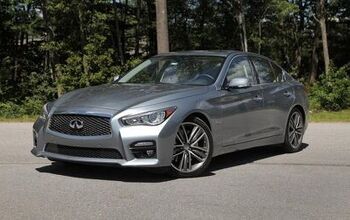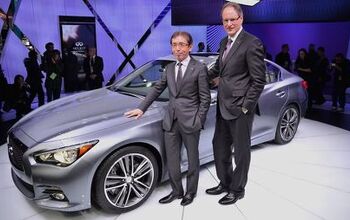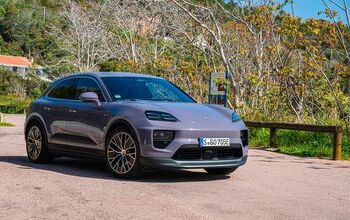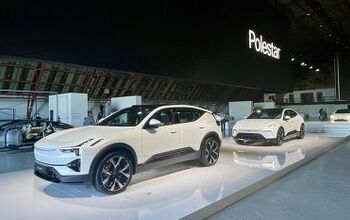2014 Infiniti Q50 Steer-by-Wire Explained

Infiniti is making an extensive push to better compete with top-tier luxury automakers around the world.
A controversial part of this far-reaching strategy included renaming every one of their products in one blinding flash. For the 2014 model year Q is in, while familiar nameplates like G, M and EX have been put out to pasture. One of the company’s most important products is the brand new Q50 sports sedan, successor to the highly successful G family.
At a recent event highlighting the car’s technology Keith St. Clair, director of product planning at Infiniti American called the Q50 “a technology showcase,” and “the essence of Infiniti brand DNA.” Living up to those promises it’s equipped with a long list of interesting technologies, but without question the Q50’s signature feature is something called Direct Adaptive Steering (DAS).
DIRECT ADAPTIVE STEERING
Essentially what engineers have done with this system is eliminate the direct physical connection between the front wheels and the steering wheel. In sort, it’s steer-by-wire.
Similar technology has been used in commercial airliners for decades not to mention other applications. NASA pioneered the technology back in the 1970s but Infiniti is the first to bring it to automobiles.
Infiniti engineer YuWun Chai worked on the system and said “we think this is the future of steering,” and if the history of other ‘by-wire’ technologies is any guide he’s right.
RE-RE-REDUNDANCY
Under normal situations there’s no physical connection between the driver and front wheels; all steering is handled by electric motors. But, as Chai noted “safety is always a first,” which is why there are multiple levels of redundancy built into DAS.
When there’s a problem that clutch engages giving the driver direct, physical steering like any other vehicle on the road.
The result of all this high-end engineering is a car with very unique driving dynamics. DAS can provide a light, loose steering experience or one that’s tight and heavy, like a dedicated sports car. But best of all each driver can customize exactly how it feels.
A DECADE OF DEVELOPMENT
“As with other ground-breaking technologies, someone has to get it started” Chai said. This one has been in development for an entire decade. He said they spent the last six or seven years tuning the system’s “feel,” a task championship winning Formula One driver Sebastian Vettel helped them with.
Regarding DAS Vettel said “I tried to give a little bit of feedback.” He said that at first, “it was not as direct as we were hoping for… now it’s very direct.” He also helped tune things like roll response, seating position and brake pedal feel “small things” according to him but attributes that result in “either driving the car or the car driving you.”
TEST DRIVE
As you might expect, DAS takes a bit of getting used to. In sport mode it’s so sharp and direct that it’s almost too easy to turn the wheel more than you need and then have to correct the vehicle’s course because you’ve gone too far. At first the overall feel is very strange.
But after a few miles, it starts to come together as you get a feel for it; the adjustable settings are pretty slick and overall DAS works better than you might expect. But it still feels like something is missing. It’s not that it’s completely synthesized like a video game, it’s far better than that, but you really seem to miss out on road texture that filters through a traditional steering system. That whole-grain sensation gives you a little more information about what the front tires are doing.
And this observation ties into something else about Infiniti’s DAS technology. Because there’s no direct link between the tiller and wheels there’s no kickback when you hit bumps and potholes. We were given an opportunity to experience this on a special “rough-road course” with simulated bumps and washboard surfaces.
Driving across these obstacles resulted in ZERO kickback from the front wheels, even as they bounced along the irregularities that were large enough to vigorously shake the car’s body.
Attempting the same task in a Q50 not equipped with DAS showed a minor but perceptible difference between the two systems. While there was absolutely no kickback in the DAS car, a small amount could be felt in the model that did not have it. Fortunately the base steering setup is so well engineered hardly any harshness filters through to the driver’s hands.
For average people, DAS is a nice addition to an already stellar sports sedan. It gives them almost total control over how the steering feels. However, all-out enthusiasts that track their Q50s on weekends might not be fond of it, but they’re definitely the minority of drivers. In reality these folks probably dislike the idea of DAS more than the actual technology itself. But this steering system becomes even more interesting when you factor in other benefits it allows.
BUT WAIT, THERE’S MORE
DAS helps enable several advanced driver-assistance systems, things like blind-spot intervention and intelligent cruise control. My marrying the Q50’s adaptive steering technology with other sensors some neat things can happen.
Many people are familiar with lane-departure warning systems. Vehicles equipped with this particular feature “read” the lines on the road and know if you get too close or cross one. They can alert the driver with an audible warning and help nudge the vehicle back into the center of its lane. Many of these systems use differential braking to achieve this, though oftentimes they can be pretty abrupt.
But with DAS an electric motor controls the steering rack. It can smoothly adjust the car’s heading and do it so gently chances are you won’t even notice. Infiniti calls this Active Lane Control. A DAS-equipped Q50 would be a tremendous road-trip machine. With adaptive cruise control monitoring forward velocity as well as Active Lane Control keeping everything pointed in the right direction the car would practically drive itself. Autonomy can’t be far off.
SEE ALSO: The Road Traveled: Origins of the 2014 Infiniti Q50
And company representatives claim there are even more benefits to DAS, things like better steering response, greater precision and reduced driver fatigue, not to mention lower cost and weight, though with a physical backup and a special clutch one wonders how either of those last two points are possible.
Direct Adaptive Steering is standard equipment on certain Q50 trim levels including the S model.
Discuss this story at our Infiniti Q50 forum.

Born and raised in metro Detroit, Craig was steeped in mechanics from childhood. He feels as much at home with a wrench or welding gun in his hand as he does behind the wheel or in front of a camera. Putting his Bachelor's Degree in Journalism to good use, he's always pumping out videos, reviews, and features for AutoGuide.com. When the workday is over, he can be found out driving his fully restored 1936 Ford V8 sedan. Craig has covered the automotive industry full time for more than 10 years and is a member of the Automotive Press Association (APA) and Midwest Automotive Media Association (MAMA).
More by Craig Cole

































Comments
Join the conversation
DAS = dumb ass steering.